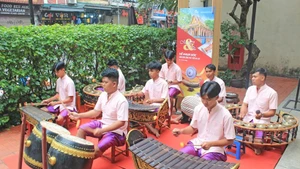A wooden burial jar with a bronze drum as a lid discovered in Phu Chanh commune, Tan Uyen town was recognised as a national treasure by the government in 2018.
The artifact was uncovered around the end of 1998 by Nguyen Van Cuong, a villager living in Vinh Tan commune, on a paddy field in Phu Chanh at a depth of around 1.8 – 2.5 metres.
Shortly after getting Cuong's reports, the Archaeological Research Centre of the Institute of Social Sciences in Ho Chi Minh City cooperated with the Binh Duong Museum to conduct a dig at the site which discovered an intact wooden burial jar and several artifacts inside.
The fragrant rosewood jar is about 61 centimetres high with its mouth at a diameter of 46 – 50 centimetres, patterned with natural wood veins. The bronze drum is close to 40 centimetres high with a drumhead diameter of 47.5 centimetres and base diameter of 44 centimetres.
The concentric drumhead has a 10-point star and it is simply decorated with the pattern of peacock feathers and inverted V-shaped details.
According to the Binh Duong Museum, the artifact is dated between the second and the first century BC (nearly 2,000 years ago).
This is a new type of tomb, the first to be discovered in an archaeological site in Vietnam and the world so far.
The use of a wooden jar with a bronze drum as a coffin is a new piece of information while studying the lifestyles of ancient resident communities in the southeastern region, according to a museum’s representative.
It is a way to show off the wealth and power of its owner and reflect the richness of his community.
The artifact is believed to be made by skillful wood carvers whose craftsmanship suggests the quite developed craft of woodworking in their time.
 |
| 3,000-year-old Doc Chua animal figure is found in Binh Duong’s Tan Uyen town in 1977 and recognised as a national treasure in 2013. (Photo: Vietnam Pictorial) |
Apart from the wooden burial jar, Binh Duong is keeping another national treasure called Doc Chua animal figure which was made around 3,000 years ago. It was found in Doc Chua archaeological site also in Tan Uyen town in 1977 and obtained the national status in 2013.
Made of bonze, the figure is 5.4cm high and 6.4cm long, and quite intact.
The animal figure stands on a rectangular base, with four nodes bending towards its legs. On the top of its head and ears are sharp broken edges which suggest the animal probably used to have two horns.
The two sides are decorated with a trapezoid-shape pattern, with a round mark looking like a sun in the middle of each side. It also has a quite large tail, a tall neck and four long legs which stand on the back of some kind of reptiles with a broken head.
Archeologists have yet to be able to confirm which animal the Doc Chua figure represents.
Still, the bronze figure in the shape of an four-legged animal standing on another was a very unique ancient artifact that has never been seen anywhere in the southeast region before.
The figure has a certain value in cultural and historical studies of burial in prehistoric times.
















